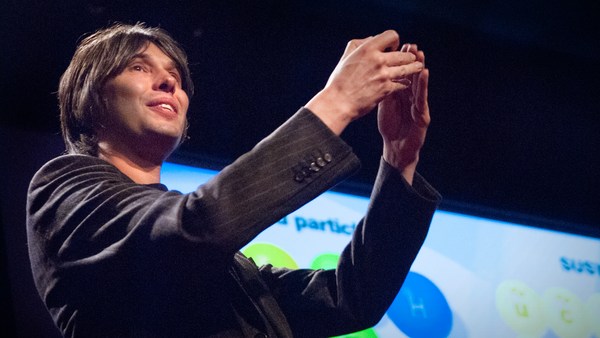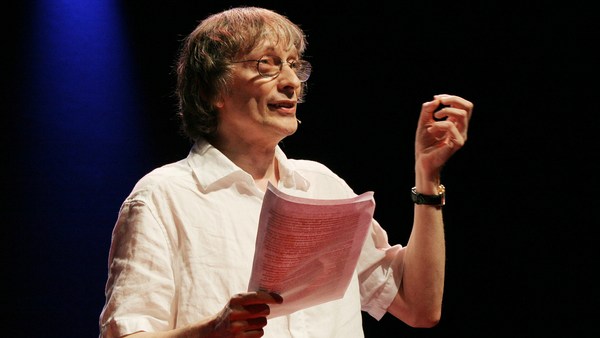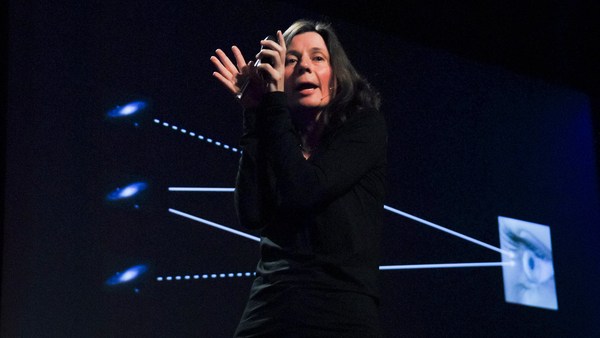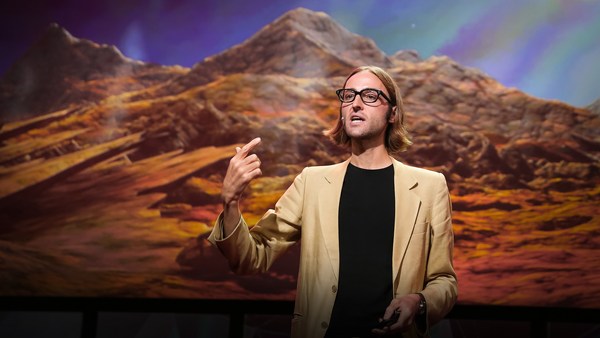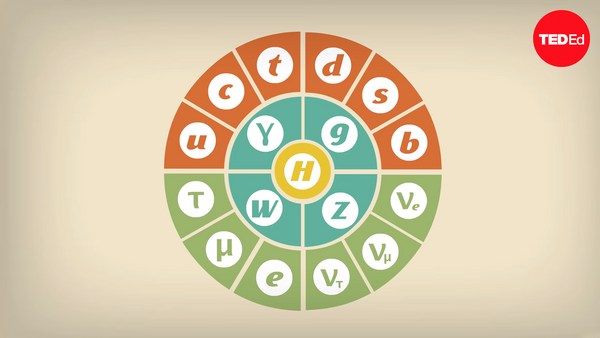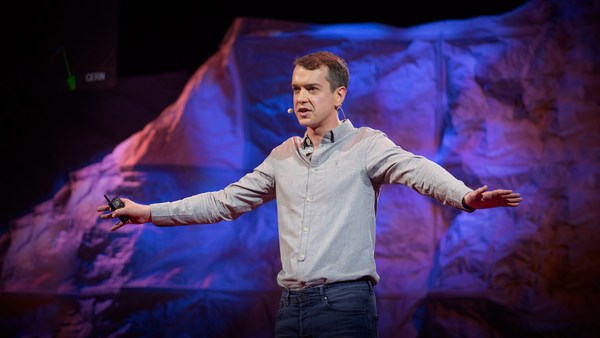Whoa, dude.
(Laughter)
Check out those killer equations. Sweet. Actually, for the next 18 minutes I'm going to do the best I can to describe the beauty of particle physics without equations. It turns out there's a lot we can learn from coral. A coral is a very beautiful and unusual animal. Each coral head consists of thousands of individual polyps. These polyps are continually budding and branching into genetically identical neighbors. If we imagine this to be a hyperintelligent coral, we can single out an individual and ask him a reasonable question. We can ask how exactly he got to be in this particular location compared to his neighbors -- if it was just chance, or destiny, or what?
Now, after admonishing us for turning the temperature up too high, he would tell us that our question was completely stupid. These corals can be kind of mean, you see, and I have surfing scars to prove that. But this polyp would continue and tell us that his neighbors were quite clearly identical copies of him. That he was in all these other locations as well, but experiencing them as separate individuals. For a coral, branching into different copies is the most natural thing in the world.
Unlike us, a hyperintelligent coral would be uniquely prepared to understand quantum mechanics. The mathematics of quantum mechanics very accurately describes how our universe works. And it tells us our reality is continually branching into different possibilities, just like a coral. It's a weird thing for us humans to wrap our minds around, since we only ever get to experience one possibility. This quantum weirdness was first described by Erwin Schrödinger and his cat. The cat likes this version better.
(Laughter)
In this setup, Schrödinger is in a box with a radioactive sample that, by the laws of quantum mechanics, branches into a state in which it is radiated and a state in which it is not.
(Laughter)
In the branch in which the sample radiates, it sets off a trigger that releases poison and Schrödinger is dead. But in the other branch of reality, he remains alive. These realities are experienced separately by each individual. As far as either can tell, the other one doesn't exist.
This seems weird to us, because each of us only experiences an individual existence, and we don't get to see other branches. It's as if each of us, like Schrödinger here, are a kind of coral branching into different possibilities. The mathematics of quantum mechanics tells us this is how the world works at tiny scales. It can be summed up in a single sentence: Everything that can happen, does. That's quantum mechanics. But this does not mean everything happens. The rest of physics is about describing what can happen and what can't. What physics tells us is that everything comes down to geometry and the interactions of elementary particles. And things can happen only if these interactions are perfectly balanced.
Now I'll go ahead and describe how we know about these particles, what they are and how this balance works. In this machine, a beam of protons and antiprotons are accelerated to near the speed of light and brought together in a collision, producing a burst of pure energy. This energy is immediately converted into a spray of subatomic particles, with detectors and computers used to figure out their properties. This enormous machine -- the Large Hadron Collider at CERN in Geneva -- has a circumference of 17 miles and, when it's operating, draws five times as much power as the city of Monterey. We can't predict specifically what particles will be produced in any individual collision. Quantum mechanics tells us all possibilities are realized. But physics does tell us what particles can be produced. These particles must have just as much mass and energy as is carried in by the proton and antiproton. Any particles more massive than this energy limit aren't produced, and remain invisible to us. This is why this new particle accelerator is so exciting. It's going to push this energy limit seven times beyond what's ever been done before, so we're going to get to see some new particles very soon.
But before talking about what we might see, let me describe the particles we already know of. There's a whole zoo of subatomic particles. Most of us are familiar with electrons. A lot of people in this room make a good living pushing them around.
(Laughter)
But the electron also has a neutral partner called the neutrino, with no electric charge and a very tiny mass. In contrast, the up and down quarks have very large masses, and combine in threes to make the protons and neutrons inside atoms. All of these matter particles come in left- and right-handed varieties, and have antiparticle partners that carry opposite charges. These familiar particles also have less familiar second and third generations, which have the same charges as the first but have much higher masses. These matter particles all interact with the various force particles. The electromagnetic force interacts with electrically charged matter via particles called photons. There is also a very weak force called, rather unimaginatively, the weak force ...
(Laughter)
that interacts only with left-handed matter. The strong force acts between quarks which carry a different kind of charge, called color charge, and come in three different varieties: red, green and blue. You can blame Murray Gell-Mann for these names -- they're his fault. Finally, there's the force of gravity, which interacts with matter via its mass and spin.
The most important thing to understand here is that there's a different kind of charge associated with each of these forces. These four different forces interact with matter according to the corresponding charges that each particle has. A particle that hasn't been seen yet, but we're pretty sure exists, is the Higgs particle, which gives masses to all these other particles. The main purpose of the Large Hadron Collider is to see this Higgs particle, and we're almost certain it will. But the greatest mystery is what else we might see. And I'm going to show you one beautiful possibility towards the end of this talk.
Now, if we count up all these different particles using their various spins and charges, there are 226. That's a lot of particles to keep track of. And it seems strange that nature would have so many elementary particles. But if we plot them out according to their charges, some beautiful patterns emerge. The most familiar charge is electric charge. Electrons have an electric charge, a negative one, and quarks have electric charges in thirds. So when two up quarks and a down quark are combined to make a proton, it has a total electric charge of plus one. These particles also have antiparticles, which have opposite charges. Now, it turns out the electric charge is actually a combination of two other charges: hypercharge and weak charge. If we spread out the hypercharge and weak charge and plot the charges of particles in this two-dimensional charge space, the electric charge is where these particles sit along the vertical direction. The electromagnetic and weak forces interact with matter according to their hypercharge and weak charge, which make this pattern. This is called the unified electroweak model, and it was put together back in 1967.
The reason most of us are only familiar with electric charge and not both of these is because of the Higgs particle. The Higgs, over here on the left, has a large mass and breaks the symmetry of this electroweak pattern. It makes the weak force very weak by giving the weak particles a large mass. Since this massive Higgs sits along the horizontal direction in this diagram, the photons of electromagnetism remain massless and interact with electric charge along the vertical direction in this charge space. So the electromagnetic and weak forces are described by this pattern of particle charges in two-dimensional space. We can include the strong force by spreading out its two charge directions and plotting the charges of the force particles in quarks along these directions. The charges of all known particles can be plotted in a four-dimensional charge space, and projected down to two dimensions like this so we can see them.
Whenever particles interact, nature keeps things in a perfect balance along all four of these charge directions. If a particle and an antiparticle collide, it creates a burst of energy and a total charge of zero in all four charge directions. At this point, anything can be created as long as it has the same energy and maintains a total charge of zero. For example, this weak force particle and its antiparticle can be created in a collision. In further interactions, the charges must always balance. One of the weak particles could decay into an electron and an antineutrino, and these three still add to zero total charge. Nature always keeps a perfect balance. So these patterns of charges are not just pretty. They tell us what interactions are allowed to happen. And we can rotate this charge space in four dimensions to get a better look at the strong interaction, which has this nice hexagonal symmetry. In a strong interaction, a strong force particle, such as this one, interacts with a colored quark, such as this green one, to give a quark with a different color charge -- this red one. And strong interactions are happening millions of times each second in every atom of our bodies, holding the atomic nuclei together.
But these four charges corresponding to three forces are not the end of the story. We can also include two more charges corresponding to the gravitational force. When we include these, each matter particle has two different spin charges, spin-up and spin-down. So they all split and give a nice pattern in six-dimensional charge space. We can rotate this pattern in six dimensions and see that it's quite pretty. Right now, this pattern matches our best current knowledge of how nature is built at the tiny scales of these elementary particles. This is what we know for certain. Some of these particles are at the very limit of what we've been able to reach with experiments. From this pattern we already know the particle physics of these tiny scales -- the way the universe works at these tiny scales is very beautiful.
But now I'm going to discuss some new and old ideas about things we don't know yet. We want to expand this pattern using mathematics alone, and see if we can get our hands on the whole enchilada. We want to find all the particles and forces that make a complete picture of our universe. And we want to use this picture to predict new particles that we'll see when experiments reach higher energies.
So there's an old idea in particle physics that this known pattern of charges, which is not very symmetric, could emerge from a more perfect pattern that gets broken -- similar to how the Higgs particle breaks the electroweak pattern to give electromagnetism. In order to do this, we need to introduce new forces with new charge directions. When we introduce a new direction, we get to guess what charges the particles have along this direction, and then we can rotate it in with the others. If we guess wisely, we can construct the standard charges in six charge dimensions as a broken symmetry of this more perfect pattern in seven charge dimensions.
This particular choice corresponds to a grand unified theory introduced by Pati and Salam in 1973. When we look at this new unified pattern, we can see a couple of gaps where particles seem to be missing. This is the way theories of unification work. A physicist looks for larger, more symmetric patterns that include the established pattern as a subset. The larger pattern allows us to predict the existence of particles that have never been seen. This unification model predicts the existence of these two new force particles, which should act a lot like the weak force, only weaker.
Now, we can rotate this set of charges in seven dimensions and consider an odd fact about the matter particles: the second and third generations of matter have exactly the same charges in six-dimensional charge space as the first generation. These particles are not uniquely identified by their six charges. They sit on top of one another in the standard charge space. However, if we work in eight-dimensional charge space, then we can assign unique new charges to each particle. Then we can spin these in eight dimensions and see what the whole pattern looks like. Here we can see the second and third generations of matter now, related to the first generation by a symmetry called "triality."
This particular pattern of charges in eight dimensions is actually part of the most beautiful geometric structure in mathematics. It's a pattern of the largest exceptional Lie group, E8. This Lie group is a smooth, curved shape with 248 dimensions. Each point in this pattern corresponds to a symmetry of this very complex and beautiful shape. One small part of this E8 shape can be used to describe the curved space-time of Einstein's general relativity, explaining gravity. Together with quantum mechanics, the geometry of this shape could describe everything about how the universe works at the tiniest scales. The pattern of this shape living in eight-dimensional charge space is exquisitely beautiful, and it summarizes thousands of possible interactions between these elementary particles, each of which is just a facet of this complicated shape.
As we spin it, we can see many of the other intricate patterns contained in this one. And with a particular rotation, we can look down through this pattern in eight dimensions along a symmetry axis and see all the particles at once. It's a very beautiful object, and as with any unification, we can see some holes where new particles are required by this pattern. There are 20 gaps where new particles should be, two of which have been filled by the Pati-Salam particles. From their location in this pattern, we know that these new particles should be scalar fields like the Higgs particle, but have color charge and interact with the strong force. Filling in these new particles completes this pattern, giving us the full E8.
This E8 pattern has very deep mathematical roots. It's considered by many to be the most beautiful structure in mathematics. It's a fantastic prospect that this object of great mathematical beauty could describe the truth of particle interactions at the smallest scales imaginable. And this idea that nature is described by mathematics is not at all new. In 1623, Galileo wrote this: "Nature's grand book, which stands continually open to our gaze, is written in the language of mathematics. Its characters are triangles, circles and other geometrical figures, without which it is humanly impossible to understand a single word of it; without these, one is wandering around in a dark labyrinth."
I believe this to be true, and I've tried to follow Galileo's guidance in describing the mathematics of particle physics using only triangles, circles and other geometrical figures. Of course, when other physicists and I actually work on this stuff, the mathematics can resemble a dark labyrinth. But it's reassuring that at the heart of this mathematics is pure, beautiful geometry. Joined with quantum mechanics, this mathematics describes our universe as a growing E8 coral, with particles interacting at every location in all possible ways according to a beautiful pattern. And as more of the pattern comes into view using new machines like the Large Hadron Collider, we may be able to see whether nature uses this E8 pattern or a different one.
This process of discovery is a wonderful adventure to be involved in. If the LHC finds particles that fit this E8 pattern, that will be very, very cool. If the LHC finds new particles, but they don't fit this pattern -- well, that will be very interesting, but bad for this E8 theory. And, of course, bad for me personally.
(Laughter)
Now, how bad would that be? Well, pretty bad.
(Laughter)
But predicting how nature works is a very risky game. This theory and others like it are long shots. One does a lot of hard work knowing that most of these ideas probably won't end up being true about nature. That's what doing theoretical physics is like: there are a lot of wipeouts. In this regard, new physics theories are a lot like start-up companies. As with any large investment, it can be emotionally difficult to abandon a line of research when it isn't working out. But in science, if something isn't working, you have to toss it out and try something else.
Now, the only way to maintain sanity and achieve happiness in the midst of this uncertainty is to keep balance and perspective in life. I've tried the best I can to live a balanced life.
(Laughter)
I try to balance my life equally between physics, love and surfing -- my own three charge directions.
(Laughter)
This way, even if the physics I work on comes to nothing, I still know I've lived a good life. And I try to live in beautiful places. For most of the past ten years I've lived on the island of Maui, a very beautiful place. Now, it's one of the greatest mysteries in the universe to my parents how I managed to survive all that time without engaging in anything resembling full-time employment.
(Laughter)
I'm going to let you in on that secret. This was a view from my home office on Maui. And this is another, and another. And you may have noticed that these beautiful views are similar, but in slightly different places. That's because this used to be my home and office on Maui.
(Laughter)
I've chosen a very unusual life. But not worrying about rent allowed me to spend my time doing what I love. Living a nomadic existence has been hard at times, but it's allowed me to live in beautiful places and keep a balance in my life that I've been happy with. It allows me to spend a lot of my time hanging out with hyperintelligent coral. But I also greatly enjoy the company of hyperintelligent people. So I'm very happy to have been invited here to TED.
Thank you very much.
(Applause)
Chris Anderson: Stay here one second.
(Applause)
I probably understood two percent of that, but I still absolutely loved it. So I'm going to sound dumb. Your theory of everything --
Garrett Lisi: I'm used to coral.
CA: That's right. The reason it's got a few people at least excited is because, if you're right, it brings gravity and quantum theory together. So are you saying that we should think of the universe, at its heart -- that the smallest things that there are, are somehow an E8 object of possibility? I mean, is there a scale to it, at the smallest scale, or ...?
GL: Well, right now the pattern I showed you that corresponds to what we know about elementary particle physics -- that already corresponds to a very beautiful shape. And that's the one that I said we knew for certain. And that shape has remarkable similarities -- and the way it fits into this E8 pattern, which could be the rest of the picture. And these patterns of points that I've shown for you actually represent symmetries of this high-dimensional object that would be warping and moving and dancing over the space-time that we experience. And that would be what explains all these elementary particles that we see.
CA: But a string theorist, as I understand it, explains electrons in terms of much smaller strings vibrating -- I know, you don't like string theory -- vibrating inside it. How should we think of an electron in relation to E8?
GL: Well, it would be one of the symmetries of this E8 shape. So what's happening is, as the shape is moving over space-time, it's twisting. And the direction it's twisting as it moves is what particle we see. So it would be --
CA: The size of the E8 shape, how does that relate to the electron? I feel like I need that for my picture. Is it bigger? Is it smaller?
GL: As far as we know, electrons are point particles, so this would be going down to the smallest possible scales. So the way these things are explained in quantum field theory is, all possibilities are expanding and developing at once. And this is why I use the analogy to coral. And -- in this way, the way that E8 comes in is it will be as a shape that's attached at each point in the space-time. And, as I said, the way the shape twists -- the directional along which way the shape is twisting as it moves over this curved surface -- is what the elementary particles are, themselves. So through quantum field theory, they manifest themselves as points and interact that way. I don't know if I'll be able to make this any clearer.
(Laughter)
CA: It doesn't really matter. It's evoking a kind of sense of wonder, and I certainly want to understand more of this.
But thank you so much for coming. That was absolutely fascinating.
(Applause)
